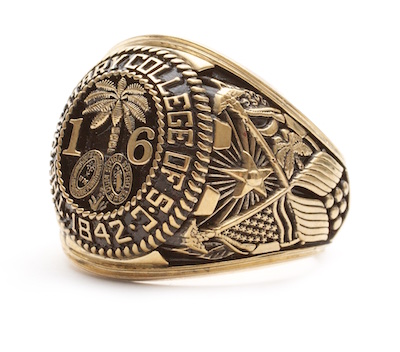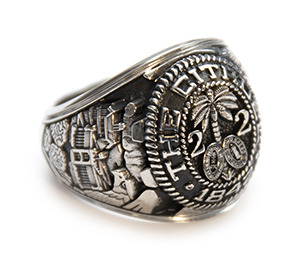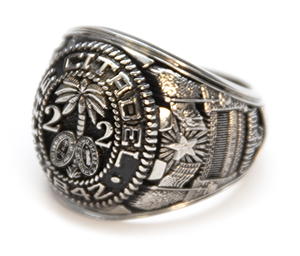
Cadet Ring History & Symbolism
The ring has symbolized outstanding accomplishments both by the Corps of Cadets and South Carolina. Perhaps the most popular feature of the ring is the Star of the West, which commemorates the firing on a Union supply steamer by a detachment of Citadel cadets in January, 1861. This action was the powder keg which set off the War Between the States.
Every aspect of the ring is symbolic of the history and tradition of the Cadet Corps from the Mexican War through both World Wars, to the present day, for The Citadel is a military college and the leadership, courage, and integrity found in good officers is embodied by the sword, found on the left shank of the ring. Crossing the sword is the rifle, the symbol of the infantry. Of equal importance in this world of political aggrandizement and perpetual military conflict are the concepts of freedom acquired and maintained only through a willingness to fight for it represented by the rifle surmounted by the oak leaves of toughness and victory blessed by peace, represented by the laurel wreath.

On the right shank of the ring are found the United States and South Carolina colors, which depict the unity of the state and federal government. The cannon balls at the bottom of this shank serve the dual purpose of representing the artillery, one of the two original branches of military instruction given during the early years of The Citadel, and as a continuing link between the Old Citadel on Marion Square and the Greater Citadel. When the college moved to its present location, the Civil War cannon balls piled before the Old Citadel were left behind. The oval crest has a reproduction of the palmetto tree in its background. Aside from representing the state tree of South Carolina, the Palmetto symbolizes a cadet-trained regiment of infantry that fought in the Mexican War and it represents a fort, built of Palmetto logs, that repelled a large British invasion fleet during the Revolutionary War. The two oval shields at the base of the tree are replicas of the state seals.
Non-Cadet Ring History and Symbolism

Where as The Citadel Cadet Ring displays the symbols and traditions of the Military College of South Carolina Corps of Cadets. The Non-Cadet Ring displays actual campus buildings and monuments that are a constant reminder of the ideals of a military college. For if The Citadel is not a military college, it is nothing. The non-Cadet student or graduate understands that it is an honor and privilege to be associated with The Military College of South Carolina, as a graduate of The Citadel Graduate College.
The Non-Cadet Ring is authorized for purchase by veteran, undergraduate evening college and graduate college students who graduate honorably from The Citadel Graduate College. Like the Cadet Ring, the Non-Cadet Ring can only be purchased in 10K white gold and is of the same pennyweight and size of the Cadet Ring. The Non-Cadet Ring is a standardized ring, which cannot be ordered with any variation, except for class year. Standardization brings two things to the importance of the ring design. First, the ring does not denote an individual graduate but a Citadel Graduate. Second, the ring can be recognized by anyone since it is of the same design from year to year, graduate to graduate.
Upon immediate glance, the Non-Cadet ring simply displays “The Citadel, 1842”. The oval crest top of the Non-Cadet Ring displays the palmetto tree- the state tree of South Carolina and is symbolic of a fort on Sullivan’s Island built from palmetto logs, which successfully resisted many British men-of-war during the Revolutionary War. To the non-Cadet graduate it represents palmetto trees that were so abundant in the area during the founding of the college in 1842. The year of non-Cadet graduation is displayed along the sides of the palmetto tree. The two oval shields at the base of the palmetto tree are miniature replicas of the state shield. The shield inscriptions are accurate and readable with a low power glass.
On the left shank of the Non-Cadet Ring the star commemorates the shelling of the union supply steamer “The Star of the West” and memorializes all those Citadel cadets, veterans, and graduates who have died in defense of their country. Lesesne Gate, the Main Gate of The Citadel campus, is named after Thomas P. Lesesne, class of 1901. On the Non-Cadet Ring, the closed Lesesne Gate represents the humbling and difficult academic task that Non-Cadet students must endure to become a wearer of the “Band of Gold”- The Non-Cadet Ring of The Citadel. Much of what a Citadel graduate gains will never be understood outside the gates of The Citadel. The United States and South Carolina colors on each side of the gate depict the unity and coordination between the state and federal government. The gate inscription The Military College of South Carolina, although appropriately unnoticeable to anyone except the wearer, is also accurate and readable with low power glass. To serve as a constant reminder of the city of their alma mater, Charleston S.C. appears on the bottom of this shank.

On the right shank of the Non-Cadet Ring, the most prominent feature is the Eagle atop Bond Hall, another campus landmark. On the Great Seal of the United States, the Eagle is facing toward the olive leaves, the symbol of peace; whereas the Bond Hall Eagle faces to the left toward the arrows, the symbol of war.
With the Daniel Library and Summerall Chapel buildings in the background of the Eagle, the Non-Cadet graduate is reminded of the beautiful architecture of the college. The library becomes the most important resource in Non-Cadet graduate degree research.
In 1985, approval was granted for purchase by all non-Cadets including master’s degree graduates. In keeping with tradition, the Alumni Association assumed the approval process for purchase following the completion of degree requirements. Therefore, The Citadel has only two official designed rings that are authorized for purchase from The Citadel Alumni Association (a cadet and a non-Cadet ring). This continues the tradition of The Citadel Ring being instantly recognizable to fellow graduates.
Significant Dates and Milestones in the Development of The Citadel Non Cadet Ring.
1945 – Mr. Stanley Sloan Betts, x’44 receives his diploma as The Citadel’s first graduate of the newly established veteran’s program. Betts had entered with the class of 1944, but had been called to active duty only to return and graduate as an “Honorably discharged United States Army Civilian Student” under the new “Serviceman’s Readjustment Act of 1944” better known as the “GI Bill.”
Between 1946 and 1960 – The Citadel enrolls a total of 2, 639 veteran students who attend classes alongside cadets with the peak years being 1946 to 1948. In 1956 The Citadel restricts enrollment to cadets only and ends the veterans program in 1960. The program is reconstituted in 1968 as Vietnam veterans entered college. Many veterans graduate and permitted to purchase class rings under the same standard regulations as cadets.
1958 – Ring Regulations are amended to state rings may be ordered by those who have been classified 1A (seniors) by the Registrar and may be secured only by those who have properly matriculated in their senior year. Cadets with advance standing must have had completed two academic years at The Citadel. Those who enter as second classmen (juniors) could only secure their rings after graduation.
1966 – The Citadel undertakes “The Citadel Evening Program” offering college courses in business, chemistry, civil engineering, education, electrical engineering, English, history, mathematics, modern languages, physics, and political science. These courses are designed for nontraditional students; adults who sought to advance and broaden their professional or vocational capabilities and interests, and were not a path to a Citadel diploma or ring.
May 1970 – The Citadel Board of Visitors reaffirms its commitment to stand ready “to assist in promoting the interests of the State of South Carolina in its program in the educational field….and assist in every manner possible the College of Charleston and/or other state supported institutions in the lower state area…”
July 1970 – The College of Charleston becomes a State supported institution. It was thought at one time that The Citadel Board of Visitors would oversee both schools however, because accreditation issues and other considerations this did not occur.
1970 – The Board of Visitors authorizes the enrollment of a limited number of junior college transfer students who were neither cadets nor veteran students to bolster the athletic programs (basketball, football).
August 1970 – The Citadel and Department of the Navy establish a Marine-oriented Naval Reserve Officers Training Corps unit at The Citadel enrolling 130 midshipmen with 16 full scholarships in its inaugural year.
September 1970 – At the meeting of the Directors of the Association of Citadel Men the question of the status of the junior college transfer students and their eligibility for the ring is raised. The answer is that under the current ring regulations they would not be eligible.
1971 – The Board of Visitors approves the awarding of baccalaureate degrees and appropriate diplomas for evening students who complete the requirements for such degrees. This is in direct response to the State’s requirements for additional and expanding educational opportunities and requirements. The Central Ring Committee would consider eligibility for these students to procure a standard class ring when they acquired standing as first classmen.
Colonel D.S. McAlister, reminding the Association Board of Directors that it had approved in its September 1970 meeting veteran students graduating from The Citadel the authorization to purchase and wear the standard class ring, brought to their attention letters appearing in the 23 April 1971 edition of the Brigadier concerning the ring being worn by those other than cadets.
December 1972 – Most of the previously mentioned Junior College transfer students departed without graduating. However, four who did applied for an exception to the ring regulations then in force permitting only cadets and veteran students to order rings. The Cadet Ring and Invitation Committee votes 3:1 in favor of granting an exception and the issue then goes before the Central Ring Committee which endorsed the recommendation.
January 1973 – The Central Ring Committee puts the recommendation before the Alumni Association Board of Directors, “the keepers of the ring” which tables the motion and appoints a special Ring Study Committee.
February 1973 – The Ring Study Committee conducts a poll of the some four hundred ring eligible members of the senior class to ascertain their opinion on the subject of rings for the four Junior college transfer students. With an 82% response rate, the senior class votes 55% to 45% in favor of an exception to the ring regulations allowing them to purchase and wear the standard cadet ring.
April 1973 – Dr. Jack W. Chandler, President of the Association of Citadel Men, calls a special meeting of the officers, directors, and past presidents of the association to come to a resolution of this “important and controversial subject.” Dr. Chandler asks the Regimental Commander, Cadet Timothy Miller and Senior class president, Cadet Ron Miller, for the sense of the corps. Both cadets reiterate that the consensus of the Corps is that there should be two rings; one for graduates who had spent at least two years in the Corps of Cadets, and another for all other graduates.
This special meeting considers two issues before them which were voted on and resolved: 1) The establishment of a special Second Ring Design Committee which passes unanimously; and 2) After a lively discussion, the Special meeting votes 12 to 4 in favor of granting an exception to the ring regulations allowing the Junior College transfer students to purchase and wear the standard cadet ring.
August 1973 – Twenty-nine enlisted Marines enroll at The Citadel under the Marine Enlisted Commissioning Education Program studying courses in political science, economics, history, English, and business administration alongside cadets and veteran students.
September 1973 – The Second Ring Design Committee, after consultation with several ring manufacturing companies, settles on a tentative design. Some of the suggested design elements included placing a bulldog on one shank, and having a stone in the top, however both of these were rejected in the final design. Elements incorporated or retained by the committee included the top oval of the standard ring included eliminating “The Military College of S.C.” and replacing it with “The Citadel.” The “Star of the West”, the South Carolina state seal, the year of graduation, and 1842 the year of the founding of the college were all considered essential.
February 1974 – The Board of Directors of the Association selects the design for the non-cadet ring submitted by the I.G. Balfour Company.
In coming to a decision on the final design of this second Citadel ring, the Ring Design Committee said of those who would wear this Citadel ring, “It should be noted that these Citadel graduates are very often superior persons who should not be treated as second raters or outcasts even though their experience has been different from that of the cadets. They, too, are credits to The Citadel, and fully deserve some proper symbol to represent their group as distinct from the members of the Corps of Cadets.”